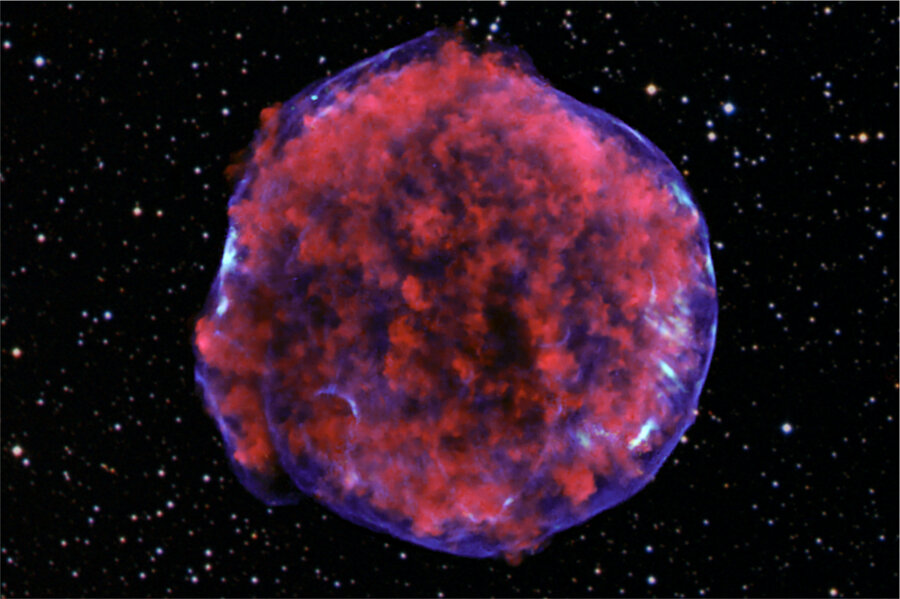Peering inside a supernova – with a Mach 1000 shock wave
Loading...
Tycho Brahe spotted a supernova in 1572, during the reign of Queen Elizabeth I. Almost 450 years later, Tycho's supernova is still offering insight into how stars explode.
Astrophysicist Hiroya Yamaguchi has mapped the leading edge of a "reverse shock wave" inside Tycho's supernova. As the shock wave pushes back from the supernova's edge toward the center, it heats detritus of the still-expanding supernova.
"The temperature cooled from billions of degrees (during the initial explosion) to a thousand degrees or less, and now we're seeing it get back up to temperatures between 1 million and 10 million degrees," says Randall Smith, who works with Dr. Yamaguchi at the Harvard-Smithsonian Center for Astrophysics (CfA) and is a co-author on the paper in an upcoming issue of Astrophysical Journal.
When a star explodes as a supernova, it's bright and hot for a few months – this one was briefly brighter than Venus – but the visible light quickly fades away, as the star's remaining material cools. But almost 500 years after the explosion of Tycho's supernova, the remnants are still emitting X-rays, visible to specialized telescopes. Why?
To answer the question, Yamaguchi looked at the heavier metals inside the supernova remnant, like iron, chromium, and manganese. And then he found something he didn't expect: Cold iron, in a place where the models predicted something else.
"He was my post-doc at the time," recalls Smith. "He came to me and said, 'This shouldn't be here. According to all of our models that we use to fit all the rest of the data, the iron should be much more evolved than this.... We're seeing something unusual, and everybody else that looked at this missed it.' I looked at it and said, 'You're absolutely right!' "
By mapping the locations of the colder and hotter iron, Yamaguchi's team discovered that the cold iron inside a supernova remnant gets flash-heated by the leading edge of the "reverse shock wave," which moves back toward the center of the supernova at about 9 million miles per hour. That's about a thousand times faster than sound could travel through the remnant material, so the researchers described the speed as "Mach 1000" in a press release.
As the leading edge of the shock wave passes through the cold iron inside Tycho's supernova, the extraordinary amount of energy in the screaming-fast shock wave heats the iron from a few hundred degrees to over a million degrees, causing it to emit X-ray light. "We wouldn't be able to study ancient supernova remnants without a reverse shock to light them up," says Yamaguchi.
So what's a "reverse shock"?
"In the supernova remnant there are two shocks, the forward shock and the reverse shock," explains Nancy Brickhouse, another co-author on the paper. When the exploding star slammed into surrounding interstellar gas, it created both shock waves: The forward shock wave is still billowing outward into space, while the reverse shock wave, like cosmic whiplash, is whipping backward, three times faster.
A tale of two telescopes
To locate the reverse shock wave, Yamaguchi used data from two X-ray telescopes, Chandra and Suzaku.
Chandra has the "best imaging performance of any X-ray telescope in the world," says Smith, but Suzaku is more sensitive to faint emissions at the energies of these X-rays, so Suzaku is actually better equipped to detect heavy metals that have already gone dark inside the explosion. The two telescopes combined to tell a surprising story, Smith says. "Chandra made a beautiful map of where the hotter iron is, but it couldn't see the colder stuff. But with a telescope that's 100 times worse in terms of blurriness, we can measure (the colder iron) now, and we can prove that it's inside the hot stuff."
"The heat of the initial explosion is immense, measured in billions of degrees," says Dr. Smith. "That drops off almost immediately," within a few months. And then comes the reverse shock wave, propagating inward over the centuries, and temperatures begin to rise again.
"We're seeing cold iron that has been less than a thousand degrees, and it's now sitting in an electron bath of 10 million degrees," says Smith. "We're catching it in the middle of the wave, just as it's passed through the reverse shock wave 'front' and is now rapidly heating up."
Hopefully, better understanding the shock waves and the internal temperature structure of the supernova remnants will help resolve some fundamental questions about these kind of explosions, called Type Ia supernovae, Smith adds.
"To give you an idea of the level of our lack of understanding: We do not know (whether) these come from two white dwarf stars that collide with each other, or one white dwarf star that ... sucks material from a regular star. Those are two very different models for how these kind of stars explode, and we don't know which one's right. We don't even know if those are the only two options." By better understanding the interior workings of Tycho's supernova, scientists are one step closer to resolving that question, known as the degenerate dwarf or double-degenerate debate.
The supernova has a few more surprises in store for astronomers. "In another few hundred years, the reverse shock wave will have reached the center, and all the gas will be hot," says Smith. It's anybody's guess what happens next.








